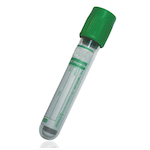Suitable Specimen Types
- Serum
- Li Hep Plasma
Specimen Transport
First Class Post.Lith Hep plasma or serum from plain (i.e. NOT yellow topped tube) is acceptable.
Sample Processing in Laboratory
UsualSample Preparation
Centrifuge sample upon reciept and separate serum/plasma.Turnaround Time
1 weekSample Stability
4 ºCThiocyanate
General Information
Upon infusion, nitroprusside (a potent vasodilator) interacts with oxyhemoglobin, forming methoxyhemoglobin and releasing 5 cyanide radicals (cyanogen) and nitric oxide. Cyanogen and nitric oxide are rapidly cleared via interactions with sulfhydryl groups in tissues and erythrocytes. Cyanogen also reacts with methemoglobin to produce cyanomethemoglobin, which is not considered to be toxic.1 Remaining cyanogen is converted to thiocyanate via sulfotransferation in the liver.
As a means to decrease, and in most cases eliminate, the risk of cyanide toxicity associated with nitroprusside administration, sodium thiosulfate should be routinely added to the infusion bag to provide a constant source of sulfur donors to facilitate conversion of cyanide to thiocyanate. Although essentially eliminating the risk of cyanide toxicity, patients should be monitored for thiocyanate toxicity, which clinically resembles cyanide toxicity (without acidosis), by means of measurement of thiocyanate serum concentrations. In cases of thiocyanate toxicity, benzodiazepines may be used to manage agitation or seizures, and hemodialysis may be used to enhance thiocyanate elimination.
From Watts, Ann Pharmacother February 2005 vol. 39 no. 2 388-389.
Patient Preparation
Used to monitor nitroprusside treatment.
Notes
Used to monitor nitroprusside therapy.
Reference Range
Provided by Reference Laboratory
Specifications
- EQA Scheme?: No
- EQA Status: No EQA available
